|
History of Romanians
Romania is situated in Central Europe,
in the northern part of the Balkan peninsula and its territory is
marked by the Carpathian Mountains, the Danube and the Black Sea.
With its temperate climate and varied natural environment, which
is favorable to life, the Romanian territory has been inhabited
since time immemorial. The research done by Romanian archaeologists
at Bugiulesti, Valcea Country, has led to the discovery of traces
of human presence dating back as early as the Lower Palaeolithic
(approximately two million years BC).
|
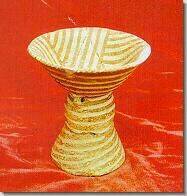
Cucuteni pottery
|
These vestiges are
among the oldest in Europe, revealing a period when "man," a
humanoid in fact, went physically and spiritually through the
stages of his coming out of the animal status. A denser human
population, ("the Neanderthal man") can be proved to have lived
about 100,000 years ago; a relatively stable population can
only be found beginning with the Neolithic (6-5,000 years BC). |
| At the time, the
population on the territory of present-day Romania created a
remarkable culture, whose proof is the polychrome pottery of
the "Cucuteni" culture (comparable to the pottery
of other important European cultures of the time in the Eastern
Mediterranean and the Middle East) and the statuettes of the
"Hamangia" culture (the Thinker of Hamangia is known
today to the whole world). |
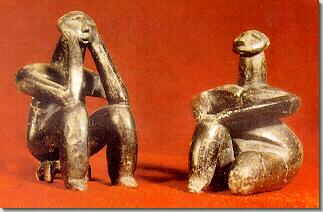
The Thinkers of Hamangia
(Neolithic statuette)
|
At the turn of the second millennium,
when the Palaeolithic age made way for the Bronze age, the Thracian
tribes of Indo-European origin settled alongside the population
that already lived in the Carpathian-Balkan region. From the time
of the Thracians on, the uninterrupted phenomenon of the Romanian
peoples birth can be traced. In the former half of the first millennium
BC, in the Carpathian-Danube-Pontic area - which was the northern
part of the large surface inhabited by the Thracian tribes - a northern
Thracian group became individualized: it was made up of a mosaic
of Getae and Dacian tribes. Strabo, a famous geographer and historian
in the age of emperor Augustus, informs that "the Dacians
have the same language as the Getae".
|
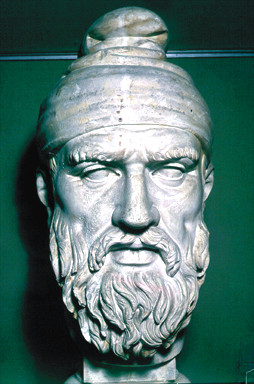
A Geto-Dacian nobleman
(tarabostes)
wearing the traditional pileus on his head
|
Basically, it was
the same people, the only difference between the Dacians and
the Getae being the area they inhabited: the Dacians - mostly
in the mountains and the plateau of Transylvania; the Getae
- in the Danube Plains. In the Antiquity, the Greeks, who first
got to encounter the Getae - used this name for the whole population
north of the Danube, while the Romans, who first got to encounter
the Dacians-extended this name to cover all the other tribes
on the present-day territory of Romania; after the conquest
of this territory, the Romans created here the Dacia province.
This is why the whole territory of present-day Romania is called
Dacia in all ancient Latin and Early Middle Ages sources. |
The contact of the Geto-Dacians with
the Greek world was made easy by the Greek colonies created on the
present-day Romanian Black Sea shore: Istros (Histria), founded
in the 7th century BC, Callatis (today: Mangalia) and Tomi (today:
Constanta); the latter two were founded a century later. In the
recorded history, the population north of the Danube (the Getae)
was first mentioned by Herodotus, "the father of history" (the 4th
century BC). He told the story of the campaign of Persian king Darius
I against the Scythians in the northern Pontic steppes (513 BC).
He wrote that the Getae were "the most valiant and just of the Thracians".
They had been the only ones to resist the Persian king on the way
from the Bosporus to the Danube.
|

The Dacian stronghold
of Sarmisegetuza
|
Burebista
(82 - around 44 BC), who succeeded to unite the Geto-Dacian
tribes for the first time, founded a powerful kingdom that stretched,
when the Dacian sovereign offered to support Pompey against
Caesar (48 BC), from the Beskids (north), the Middle Danube
(west), the Tyras river (the Dniester), and the Black Sea shore
(east) to the Balkan Mountains (south). |
In the 1st century BC, as the Roman
empire was expanding and Roman provinces were being created in Pannonia,
Dalmatia, Moesia and Thracia, the Danube became, along 1,500 Km.,
the border between the Roman Empire and the Dacian world. In Dobrudja,
which was under Roman rule for seven centuries beginning with the
reign of Augustus, poet Publius Ovidius Naso spent the last years
of his life, "among Greeks and Getae," as he was exiled there, to
Tomi (8-17, AD) by order of the same Caesar.
| Dacia was at the
peak of its power under King Decebal (87-106 AD). After
a first confrontation during the reign of Domitian (87-89),
two extremely tough wars were necessary (101-102 and 105-106)
to the Roman empire, at the peak of its power under Emperor
Trajan (98-117) to defeat Decebal and turn most of his kingdom
into the Roman province called Dacia. |
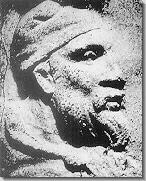
King Decebal
|
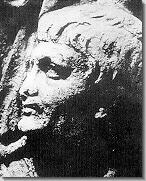
Emperor Trajan
|
|
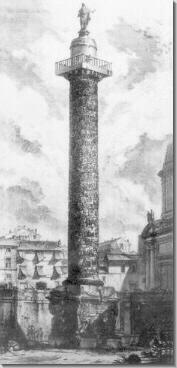
Trajan's Column in Rome
-
the birth certificate of the Romanian people
|
Trajans
Column erected in Rome and the Triumphal Monument at Adamclisi
(Dobrudja) tell the story of this military effort, which was
followed by a systematic and massive colonization of the new
territories that were integrated into the empire.
|
| The Dacians, although
they had suffered heavy casuals, remained, even after the new
rule was established, the main ethnic element in Dacia; the
province was subjected to a complex Romanization process, its
basic element being the staged but definitive adoption of the
Latin language. |

The Roman monument of
Adam Clisi (second century AD)
|
The Romanians are today the only descendants
of the Eastern Roman stock; the Romanian language is one of the
major heirs of the Latin language, together with French, Italian,
Spanish; Romania is an oasis of Latinity in this part of Europe.
|
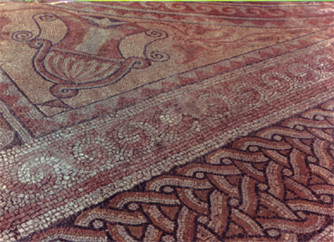
The Roman mosaic of Tomis
(Constanta)
|
The natives, be they
of Roman or Daco-Roman descent, continued their uninterrupted
existence as farmers and shepherds even after the withdrawal,
under emperor Aurelian (270-275) of the Roman army and administration,
which were moved south of the Danube. But the ancestors of the
Romanians remained for several centuries in the political, economic,
religious and cultural sphere of influence of the Roman Empire;
after the empire split in 395 AD, they stayed in the sphere
of the Byzantine Empire. They lived mostly in the old Roman
hearts that had now decayed and survived in difficult circumstances
under successive waves of migratory tribes. |
At the time when the Daco-Roman ethno-cultural
symbiosis was achieved and finalized in the 6-7th centuries by the
formation of the Romanian people, in the 2-4th centuries, the Daco-Romans
adopted Christianity in a Latin garb.
Therefore, in the 6-7th centuries,
when the formation process of the Romanian people was done, this
nation emerged in history as a Christian one. This is why, unlike
the neighboring nations, which have established dates of Christianization
(the Bulgarians - 865, the Serbs - 874, the Poles-966, the eastern
Slavs - 988, the Hungarians - the year 1000), the Romanians do not
have a fixed date of Christianization, as they were the first Christian
nation in the region.
In the 4-13th centuries the Romanian
people had to face the waves of migrating peoples - the Getae, the
Huns, the Gepidae, the Avars, the Slavs, the Petchenegs, the Cumanians,
the Tartars - who crossed the Romanian territory.
The migratory tribes controlled this
space from the military and political points of view, delaying the
economic and social development of the natives and the formation
of local statehood entities.
The Slavs, who massively settled since
the 7th century south of the Danube, split the compact mass of Romanians
in the Carpathian-Danubian area: the ones to the north (the Daco-Romanians)
were separated from the ones to the south, who were moved towards
the west and Southeast of the Balkan Peninsula (Aromanians, Megleno-Romanians
and Istro-Romanians). The Slavs that settled north of the Danube
were assimilated little by little by the Romanian people and their
language left traces in the vocabulary and phonetics of the Romanian
language. To the Romanian language, the Slavic language (similarly
to the Germanic idiom of the Franks with the French people) was
the so-called super-imposed layer. The Romanians belonged to the
Orthodox religion so they adopted the Old Church Slavic as a cult
language, and, beginning with the 14-16th centuries, as a chancery
and culture language. The Slavic language was never a living language,
spoken by the people, on the territory of Romania; it played for
Romanians, at a certain time during the Middle Ages, the same role
that Latin played in the West; in the early modern age it was replaced
for ever, in church, chancery and culture included, by the Romanian
language.
Owing to their position, the Romanians
south of the Danube were the first to be mentioned in historical
sources (the 10th century), under the name of vlahi or
blahi (Wallachians); this name shows they were speakers of a
Romance language and that the non-Roman peoples around them recognised
this fact.
After the year 602, the Slavs massively
settled south of the Danube and they established a powerful Bulgarian
czardom in the 9th century; this, cut the tie between the Romanian
world north of the Danube and the one south of the Danube. As they
were subjected to all sorts of pressures and isolated from the powerful
Romanian trunk north of the Danube, the number of Romanians south
of the Danube continuously decreased, while their brothers north
of the Danube, although living in extremely difficult circumstances,
continued their historical evolution as a separate nation, the farthest
one to the east among the descendants of Imperial Rome.
In fact the Romanians are the only
ones who, through their very name - roman - (coming from the Latin
word "Roman") - have preserved to this day in this part of Europe
the seal of the ancestors, of their descent, that they have always
been aware of. This will show later in the name of the nation state
- Romania.
Wallachia, Moldavia, Transylvania
Beginning with the 10th century, the
Byzantine, Slav and Hungarian sources, and later on the western
sources mention the existence of statehood entities of the Romanian
population - kniezates and voivodates - first in Transylvania and
Dobrudja, then in the 12-13th centuries, also in the lands east
and south of the Carpathians. A specific trait of the Romanians
history from the Middle Ages until the modern times is that they
lived in three Principalities that were neighbors, but autonomous
- Wallachia, Moldavia and Transylvania.
This phenomenon - which is by no means
unique in Mediaeval Europe - is extremely complex. The underlying
causes pertain to the essence of the feudal society, but there are
also specific factors. Among the latter, we wish to mention the
existence of powerful neighboring empires, which opposed the unification
of the Romanian state entities and even occupied - for shorter or
longer periods of time - Romanian territories. For instance, to
the west the Romanians had to face the policy of conquests conducted
by the Hungarian kingdom. In 895, the Hungarian tribes, who came
from the Volga lands, led by Arpad, settled in Pannonia. They were
stopped in their progress towards the west by emperor Otto I (995)
so the Hungarians settled down and turned their eyes to the south-east
and east. There they encountered the Romanians.
A Hungarian chronicle describes the
meeting between the messengers sent by Arpad, the Hungarian king,
and voivode Menumorut of the Biharea city in western Transylvania.
The Hungarian ambassadors demanded that the territory be handed
over to them. The chronicle has preserved for us the dignified answer
given by Menumorut: "Tell Arpad, the Duke of Hungary, your ruler.
Verily we owe him, as a friend to a friend, to give him all that
is necessary because he is a foreigner and a stranger and lacks
many. But the land that he has demanded from our good will we shall
never give to him, as long as we are alive".
|
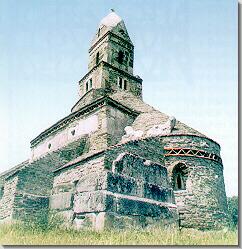
The Church of Densus
|
Despite the resistance
of the Romanian kniezates and voivodates, the Hungarians succeeded
in the 10-13th centuries to occupy Transylvania and make it
part of the Hungarian kingdom (until the beginning of the 16th
century as an autonomous voivodate.) In order to consolidate
their power in Transylvania, where the Romanians continued to
be, over the centuries, the great majority ethnic element, as
well as to defend the southern and eastern borders of the voivodate,
the Hungarian crown resorted to the colonization of Szecklers
and Germans (Saxons) in the 12-13th centuries in the frontier
areas. |
| In the 14th century,
with the decline of the neighboring imperial powers (the Poles,
the Hungarians, the Tartars), south and east of the Carpathian
Mountains range the autonomous feudal states were formed: Wallachia,
under Basarab I (around 1310) and Moldavia, under
Bogdan I (around 1359). The Polish and Hungarian kingdoms
attempted in the 14-15th centuries to annex or subordinate the
two principalities, but they did not succeed. |
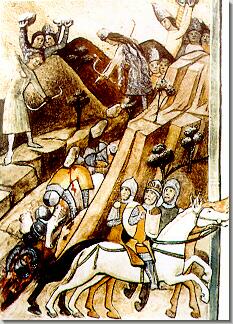
Scene from the Painted
Chronicle of Vienna showing
the victory of the Romanians at Posada (1330)
against the army of the Hungarian King
|
In the second half of the 14th century
a new threat against the Romanian lands emerged: the Ottoman Empire.
After first setting foot on European soil in 1354, the Ottoman Turks
began their rapid expansion on the continent, so the green banner
of the Islam already flew south of the Danube in 1396.
|
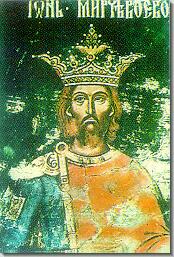
Mircea the Old,
Voivode of Wallachia (1386-1418)
|
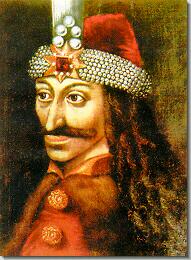
Vlad the Impeller,
Voivode of Wallachia
(Dracula of the Mediaeval legends, 1456-1462)
|
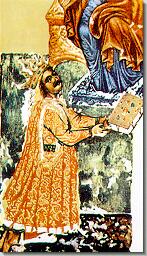
Stephen the Great and
Holy,
Voivode of Moldavia (1457-1504)
|
Alone or in alliance
with the neighboring Christian countries, more often in alliance
with the neighboring voivodes of the other two Romanian principalities,
the voivodes of Wallachia Mircea the Old (1386-1418)
and Vlad the Impeller (Dracula of the Mediaeval legends,
1456-1462), with Stephen the Great and Holy (1457-1504),
the voivode of Moldavia and Iancu of Hunedoara, the
voivode of Transylvania (1441-1456) fought heavy defence battles
against the Ottoman Turks, delaying their expansion to Central
Europe. |
The whole Balkan Peninsula became
a Turkish-ruled territory, Constantinople was captured by Mohammed
II (1453), Suleiman the Magnificent captured the city of Belgrade
(1521), and the Hungarian kingdom disappeared following the battle
of Mohacs (1526). Therefore, Wallachia and Moldavia were surrounded
and they had to recognize for over three centuries the suzerainty
of the Ottoman Empire. After Buda was captured and Hungary became
a pashalik, Transylvania became a selfruling principality
(1541) and it, too, recognized the suzerainty of the Ottoman Empire,
as the other two Romanian lands.
| Unlike all the other
peoples of south-east Europe, unlike the Hungarians and the
Poles, the Romanians were the only ones who maintained their
state entity during the Middle Ages, along with their own political,
military and administrative structures. The tribute paid to
the sultan was the guarantee for the preservation of domestic
autonomy, but also for the protection against more powerful
enemies. |

City of Soroca on the
Dnister river bank
|
|

The Curtea de Arges Monastery,
founded by Neagoe Basarab
(1512-1521), Prince of Wallachia
|
Wallachia and Moldavia,
owing to their autonomy status, continued after the fall of
the Byzantine Empire to foster their Byzantine cultural traditions,
taking at the same time upon themselves to protect the Eastern
Orthodox religion; on their territory, scholars from all over
the Balkan Peninsula, chased away by the intolerant Islam, were
able to continue their work without any obstacles; they prepared
the cultural revival of their nations. |
| The end of the 16th
century was dominated by the personality of Michael the
Brave. He became voivode of Wallachia in 1593, joined the
Christian League - an anti-Ottoman coalition initiated by the
Papacy and the Holy Roman Empire and he succeeded, following
heavy battles (Calugareni, Giurgiu) to actually regain the independence
of his country. In 1599-1600 he united for the first time in
history all the territories inhabited by Romanians, proclaiming
himself "prince of Wallachia, Transylvania and the whole of
Moldavia." The domestic situation was very complex, the neighboring
great-powers - the Ottoman Empire, Poland, the Hapsburg Empire
- were hostile and joined forces to overthrow him; so this union
was short-lived as Michael the Brave was assassinated in 1601. |
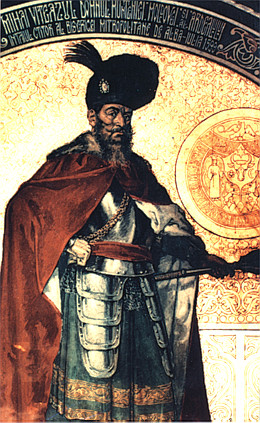
Michael the Brave (1593-1601),
prince of Wallachia,
the first to unite the Romanian feudal states
|
|

Michael the Brave entering
Alba Iulia on November 1, 1599
|
The union achieved
by the valiant voivode became, however, a symbol to the posterity.
In the 17th century, in various forms and with evanescent success,
other princes attempted to restart the ambitious political program
of Michael the Brave, by trying to form a united anti-Ottoman
front, made-up of the three principalities and to restore the
unity of ancient Dacia.
Michael the Brave (1593-1601)
who first united the three Romanian lands.
|
The end of the 17th century and the
beginning of the 18th century brought about changes in the politics
of Central and Eastern Europe. The Ottoman Empire failed to capture
Vienna in 1683 and following that, the Hapsburg Empire began its
expansion to the south-east of Europe. The Austrian-Turkish peace
treaty of Karlowitz (1699) sanctioned the annexation of Transylvania
and its organization as an autonomous principality to Hapsburg Austria
(since 1765 great principality), ruled by a governor. Poland was
divided and Russia, by successive conquests, reached under Peter
the Great (1696-1725) the Dniester river, thus becoming Moldavias
eastern neighbor.
The ambitious dream of the czars to
dominate the Bosporus strait and Constantinople placed the Romanian
Principalities in the way of Russian expansionism. The Ottoman Empire,
in an attempt to defend its old position, introduced in Moldavia
(1711) and Wallachia (1716) the "Phanariot regime,"
(until 1821), under which the Sublime Porte appointed in the two
principalities Greek voivodes recruited from the Phanar district
of Istanbul and considered faithful to the Turks. That was a time
when the Ottoman political control and economic exploitation increased
and corruption spread; but some social reforms were also introduced
- such as the abolition of serfdom - as well as administrative and
modernizing reforms, modeled on the European ones in the age of
the Enlightenment. The domestic autonomy, although limited, was
basically preserved and the two principalities continued to be distinct
entities from the Ottoman Empire; this situation was recognized
in several international treaties (for instance that of Kuchuk-Kainargi,
1774). Lying at the borders of three great empires and wanted
by all three of them, Wallachia and Moldavia became for over 150
years not only territories of contention but also a battlefield
on which the armies of the empires fought each other.
Many wars were fought by Austria and
Russia against the Ottoman Empire (1710-1711, 1716-1718, 1735-1739,
1768-1774, 1787-1792, 1806-1812, 1828-1829, 1853-1856): those battles
took place on Romanian soil, always
accompanied by a foreign military occupation, which was often maintained
long after the war proper was over, so the Romanian lands endured
not only through devastation and irrecoverable losses but also through
population displacements and painful territory amputations. So,
Austria temporarily annexed Oltenia (1718-1793) and Northern Moldavia
that they called Bukovina (1775-1918). Following the Russian-Turkish
war of 1806-1812, Russia annexed the eastern part of Moldavia, the
land between the Prut and Dniester rivers, later called Bessarabia
(1812-1918).
National Revival
In the 18th and early 19th centuries
huge economic and social changes took place, the feudal structures
were deeply eroded, the first capitalist enterprises emerged and
at the same time Romanian goods were attracted step by step into
the European circuit. The national idea, as everywhere else in Europe,
was becoming the soaring dream of intellectuals and the underlying
element in the plans for the future made by the politicians.
| The union of part
of the clergy in Transylvania with the Catholic Church (the
Greek- Catholics), achieved by the House of Hapsburg in 1699-1701,
played an important part in the emancipation of Transylvanian
Romanians. Their fight for equal rights with the other ethnic
groups (although the Romanians accounted for over 60% of the
principates population, they were still considered "tolerated"
in their own country) was begun by Bishop Inocentiu Micu-Klein
and continued by the intellectuals grouped in the "Transylvanian
School" movement: Gheorghe Sincai, Petru Maior,
Samuil Micu, Ion Budai-Deleanu, a.o. |
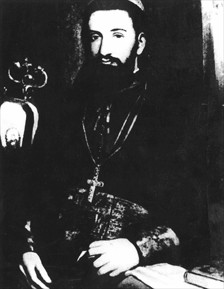
Greek-Catholic bishop
Inocentiu Micu-Klein (1692-1768), promoter of the national
struggle
of the Romanians in Transylvania
|
These scholars proved the Latinity
of the Romanian language and people and, even more, the fact that
they had uninterruptedly been the autochthonous population here.
By virtue of this ancients, they demanded equal rights with the
other "nations" in Transylvania - Hungarians, Szecklers and Saxons.
The claims of the Romanians in Transylvania were submitted to the
Court of Vienna in the long petition called Supplex Libellus
Valachorum (1791), which did not receive any answer.
|
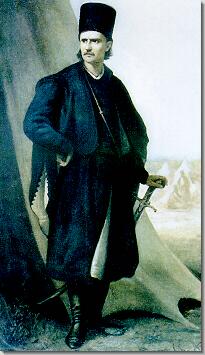
Tudor Vladimirescu,
the leader of the 1821 Romanian revolution
|
The quest for renewal
in Wallachia was expressed in the revolution led by Tudor
Vladimirescu (1821), which broke out at the same time with
the Greeks movement for liberation.
|
Although the Ottoman and Czarist troops
occupied the Danube principalities that same year, the sacrifices
made by the Romanians brought about the abolition of the Phanariot
regime and native voivodes were again appointed on the thrones of
Moldavia and Wallachia. The peace treaty of 1829 signed at Adrianople
(today Edirne) ended the Russian-Turkish conflict of 1828-1829,
which had broken out in the final stage of the war for national
liberation fought by the Greeks; this treaty greatly weakened the
Ottoman suzerainty, but it increased Russias "protectorate." Now
that trade was freed, Romanian cereals began to penetrate European
markets. Under Pavel Kiseleff, the commander of the Russian troops
that occupied the two Romanian principalities (1828-1834), quasi-identical
Organic Regulations were introduced in Wallachia (1831) and Moldavia
(1832); until 1859 these Regulations served as fundamental laws
(constitutions) and they contributed to the modernisation and homogenisation
of the social, economic, administrative and political structures
that had started in the preceding decades. Therefore, in the first
half of the 19th century, the Romanian principalities began to distance
themselves from the Oriental Ottoman world and tune into the spiritual
space of Western Europe. Ideas, currents, attitudes from the West
were more than welcome in the Romanian world, which was undergoing
an irreversible process of modernization. Now the awareness that
all Romanians belong to the same nation was generalized and the
union into one single independent state became the ideal of all
Romanians.
Union and Independence
The winds of 1848 also blew over the
Romanian principalities.
| They brought to the
centre-stage of politics several brilliant intellectuals such
as Ion Heliade Radulescu, Nicolae Balcescu, Mihail Kogalniceanu,
Simion Barnutiu, Avram Iancu and others. |
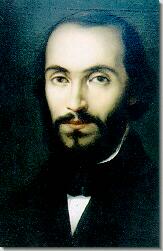
Nicolae Balcescu, one
of the 1848 revolution leaders
|
In Moldavia the unrest was quickly
cracked down on, but in Wallachia the revolutionaries actually governed
the country in June-September 1848.
|

Avram Iancu,
leader of the 1848 Romanian revolution in Transylvania
|
In Transylvania the
revolution was prolonged until as late as 1849. There, the Hungarian
leaders refused to take into account the claims of the Romanians
and they resolved to annex Transylvania to Hungary; this led
to a split of the revolutionary forces between the Hungarians
and the Romanians. The Hungarian government of Kossuth Lajos
attempted to crack down on the fight of the Romanians, but he
encountered the resolute armed resistance of the Romanians in
the Apuseni Mountains, under the leadership of Avram Iancu. |
Although the brutal intervention of
the Ottoman, Czarist and Hapsburg armies was successful in 1848-1849,
the renewal tide favoring democratic ideas spread everywhere in
the next decade.
Russia was defeated in the Crimean
War (1853-1856) and this called into question again the fragile
European balance. Owing to their strategic position at the mouth
of the Danube, as this waterway was becoming increasingly important
to European communications, the status of the Danube principalities
became a European issue at the peace Congress in Paris (February-March
1856). Wallachia and Moldavia were still under Ottoman suzerainty,
but now they were placed under the collective guarantee of the seven
powers that signed the Paris peace treaty; these powers decided
then that local assemblies be convened to decide on the future organization
of the two principalities. The Treaty of Paris also stipulated:
the retrocession to Moldavia of Southern Bessarabia, which had been
annexed in 1812 by Russia (the Cahul, Bolgrad and Ismail counties);
freedom of sailing on the Danube; the establishment of the European
Commission of the Danube; the neutral status of the Black Sea.
In 1857 the "Ad-hoc assemblies" convened
in Bucharest and Iasi under the provisions of the Paris Peace Congress
of 1856; all social categories participated and these assemblies
unanimously decided to unite the two principalities into one single
state. French emperor Napoleon III supported this, the Ottoman Empire
and Austria were against, so a new conference of the seven protector
powers was called in Paris (May-August 1858); there, only a few
of the Romanians claims were approved.
| But the Romanians
elected on January 5/17, 1859 in Moldavia and on January 24/February
5, 1859 in Wallachia Colonel Alexandru Ioan Cuza as
their unique prince, achieving de facto the union of the two
principalities.
The Romanian nation state took
on January 24/February 5, 1862 the name of ROMANIA and settled
its capital in Bucharest.
|

Alexandru Ioan Cuza
(1859-1866),
Voivove of the United Principalities
|
|
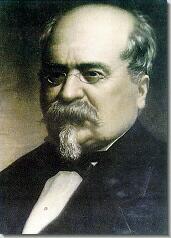
Mihail Kogalniceanu (1817-1890),
father of the program to make Romania a modern country
|
Assisted by Mihail
Kogalniceanu, his closest adviser, Alexandru Ioan Cuza initiated
a reform program, which contributed to the modernization of
the Romanian society and state structures: the law to secularise
monastery assets (1863), the land reform, providing for the
liberation of the peasants from the burden of feudal duties
and the granting of land to them (1864), the Penal Code law,
the Civilian Code law (1864), the education law, under which
primary school became tuition free and compulsory (1864), the
establishment of universities in Iasi (1860) and Bucharest (1864),
a.o. |
| After the abdication
of Alexandru Ioan Cuza (1866), Carol of Hohenzollern-Sigmaringen,
a relative of the royal family of Prussia, who was supported
by Napoleon III and Bismark, was proclaimed on May 10, 1866,
following a plebiscite, ruling prince of Romania, with the name
of Carol I. |
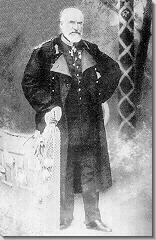
Carol I, first King
of Romania
|
The new Constitution (inspired from
the Belgian one of 1831), which was promulgated in 1866 and was
in use until 1923, proclaimed Romania a constitutional monarchy.
In the next decade the struggle of the Romanians to achieve full
state independence was part of the movements that took place with
other peoples in the south-east of Europe - Serbs, Hungarians, Montenegrins,
Bulgarians, Albanians - to cut off their last ties to the Ottoman
Empire. Within a favorable international framework - in 1875 the
Oriental crisis broke out again and the Russo-Turkish war started
in April 1877 - Romania declared its full state independence on
May 9/21, 1877. The government led by Ion C. Bratianu, in
which Mihail Kogalniceanu served as Foreign Minister, decided, upon
the Russian request for assistance, to join the Russian forces that
were operative in Bulgaria.
|
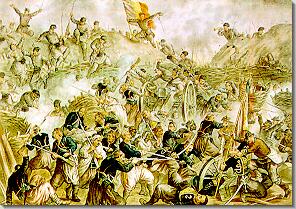
Attack of Grivita stronghold
Engraving of the Independence War period (1877-1878)
|
A Romanian army,
under the personal command of Prince Carol I, crossed the Danube
and participated in the siege of Pleven; the result was the
surrender of the Ottoman army led by Osman Pasha (December 10,
1877). |
The independence of Romania, similarly
to that Serbia and Montenegro, as well as the union of Dobrudja
with Romania were recognized in the Russian-Turkish peace treaty
of San Stefano (March 3, 1878). Upon the insistence of the great
powers, an international peace Congress was held in Berlin (June-July
1878), which acknowledged and maintained the status that Romania
had proclaimed by herself more than a year before; it also re-established,
after a long period of Ottoman rule, Romanias rights over Dobrudja,
which was re-united to Romania. But at the same time Russia violated
the convention signed on April 4, 1877 and forced Romania to cede
the Cahul, Bolgrad and Ismail counties of Southern Bessarabia.
On March 14/26, 1881, Romania proclaimed
itself a kingdom and Carol I of Hohenzollern-Sigmaringen was crowned
King of Romania.
After gaining its independence, the
Romania state was the place to which the hopeful eyes of all Romanians
who lived on the lands still under foreign occupation turned. The
Romanians in Bukovina and in Bessarabia were facing a systematic
policy of assimilation into the German and Russian worlds, respectively.
Immigration of foreign peoples was directed to their territory.
The Romanian enclaves in the Balkan Peninsula had increasing difficulties
in opposing the denationalization tendencies. At the turn of the
20th century, the Romanians were a people with over 12 million inhabitants,
of whom almost half lived under foreign occupation.
At the same time in Transylvania,
the Romanians suffered the serious consequences of the accord by
which the Hungarian state was re-established more than three centuries
after its collapse and the dual Austria-Hungary state was created
(1867). Transylvania lost the autonomous status it had under Austrian
rule and it was incorporated into Hungary. The legislation passed
by the government in Budapest, which proclaimed the existence of
only one nationality in Hungary - the Magyar one - sought to destroy
from the ethno-cultural point of view the other populations, by
forcing them to become Hungarian. This subjected the Romanian population,
along with other ethnic groups, to heavy ordeals. At that time the
National Romanian Party in Transylvania played an important role
in asserting the Romanian national identity; the party was reorganized
in 1881 and it became the standard bearer in the struggle to achieve
recognition of equal rights of the Romanian nation and it the resistance
against the denationalization projects.
| In 1892 the national
struggle of the Romanians reached a climax through the Memorandum
Movement. The memorandum was drafted by the leaders of the Romanians
in Transylvania, Ion Ratiu, Gheorghe Pop of Basesti, Eugen
Brote, Vasile Lucaciu, a.o. and it was sent to Vienna to
be submitted to emperor Franz Joseph I; it advised the European
public opinion of the Romanians claims and of the intolerance
shown by the government in Budapest regarding the national issue. |

The Group of memorandum
champions,
members of the Romanian National Party of Transylvania, sentenced
to hard years of prison by the
Hungarian courts of law in 1894
|
The 1878-1914 period was one of stability
and progress for Romania. Politics got polarized around two huge
parties - the conservative one (Lascar Catargiu, P.P. Carp, Gh.
Grigore Cantacuzino, Titu Maiorescu, a.o.) and the liberal one
(Ion C. Bratianu, Dimitrie A. Sturdza, Ion I.C. Bratianu,
a.o.). They alternatively came to power and this became the characteristic
trait of the epochs politics.
The expansionist policy of Russia
determined Romania to sign in 1883 a secret alliance treaty with
Austria-Hungary, Germany and Italy; the treaty was renewed periodically
until World War I. After staying neutral in the first Balkan war
(1912-1913) Romania joined Greece, Serbia, Montenegro and Turkey
against Bulgaria in the second Balkan war. The peace treaty of Bucharest
(1913) marked the end of that conflict and under its provisions
Southern Dobrudja - the Quadrilateral (the Durostor and Caliacra
counties) became part of Romania.
|
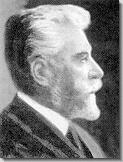
Ion I.C. Bratianu, Prime Minister of Romania
|
In August 1914, when
World War I broke out, Romania declared neutrality. Two years
later on August 14/27, 1916 it joined the Allies, which promised
support for the accomplishment of national unity; the government
led by Ion I.C. Bratianu declared war on Austria-Hungary. |
After the first success, the Romanian
army was forced to abandon part of the country, Bucharest included
and to withdraw to Moldavia, owing to the joint offensive of the
armies in Transylvania, commanded by General von Falkenhayn and
those of Bulgaria, commanded by Marshal von Mackensen.
| In the summer of
1917, in the great battles of Marasti, Marasesti and Oituz,
the Romanians aborted the attempt made by the Central Powers
to defeat and get Romania out of the war by occupying the rest
of her territory. |
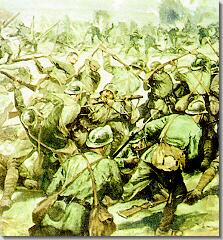
Fighting at Marasesti
- Engraving of WWI
|
But the situation changed completely
following the outbreak of the revolution in Russia (1917) and the
separate peace concluded by the Soviets at Brest-Litovsk (March
3, 1918); this triggered the end of the military operations on the
eastern front. Romania was compelled to follow in the steps of her
Russian ally, because on the Moldavian front the Romanian troops
were interspersed with the Russian ones and it was impossible for
combat to continue on one area of the front and for peace to settle
on another front area, and so on. Cut off from its western allies,
Romania was forced to sign the peace treaty of Bucharest with the
Central Powers (April 24/May 7, 1918). The ratification procedure
was never carried through, so from the legal standpoint the treaty
was never operative; in fact, in late October 1918, Romania denounced
the treaty and re-entered the war.
|
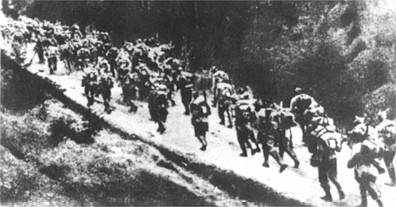
Romanian army crossed
the Carpathians
to free Transylvania, an ancient Romanian land
|
The right of the
peoples to self-rule triumphed in the final stage of World War
I and this served the cause of the Romanians who lived in the
Czarist and Austro-Hungarian Empires. |
The collapse of the czarist system
and the recognition by the Soviet government of the right of the
exploited peoples to self-rule allowed the Romanians in Bessarabia
to express through the vote of the national representative body
- the Country Council which convened in Chisinau - their will to
be united with Romania (March 27/April 9, 1918). The fall of the
Hapsburg monarchy in the autumn of 1918 made it possible for the
nations that had been under Austrian-Hungarian oppression to emancipate
themselves.
| On November 15/28,
1918, the National Council of Bukovina voted in Cernauti to
unite that province to Romania. |
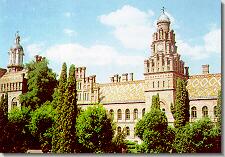
The Metropolitan Palace of Cernauti, where
the union of Bukovina with Romania was voted (November 28,
1918)
|
|
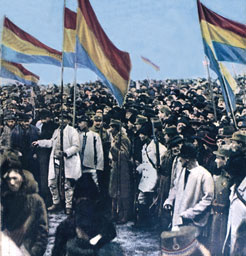
The Great National Assembly
of Alba Iulia, on December 1 1918
|
In Transylvania the
National Assembly called at Alba Iulia on November 18/December
1, 1918 voted, within the presence of over 100,000 delegates,
to unite Transylvania and Banat with Romania. |
| So, in January 1919,
when the peace conference was inaugurated in Paris, the union
of all Romanians into one single state was an accomplished fact. |
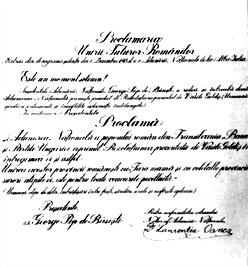
The act proclaiming the union of Transylvania to the kingdom
of Romania on December 1, 1918
|
The international peace treaties of
1919-1920 signed at Neuilly, Saint-Germain, Trianon and Paris, established
the new European realities and also sanctioned the union of the
provinces that were inhabited by Romanians into one single state
(295,042 square kilometers, with a population of 15.5 million).
The universal suffrage was introduced
(1918), a radical reform was applied (1921), a new Constitution
was adopted - one of the most democratic on the continent (1923)
- and all this created a general-democratic framework and paved
the way for a fast economic development (the industrial output doubled
between 1923 and 1938). With its 7.2 million metric tons of produced
oil in 1937, Romania was the second largest European producer and
number seven in the world. The per capita national income reached
$94 in 1938 as compared to Greece - $76, Portugal - $81, Czechoslovakia
- $141, and France - $246.
| In politics many
parties competed with one another, so the government was controlled
over the years by several of them: the Peoples Party (Alexandru
Averescu), the National Liberal Party (Ion I.C. Bratianu,
I.G. Duca, Gheorghe Tatarescu) and the National Peasant
Party (Iuliu Maniu). |

Iuliu Maniu,
President of the National Peasant Party
|
The Romanian Communist Party, established
in 1921, and which had an insignificant number of members, was banned
in 1924. The Iron Guard, an extremist right-wing nationalist movement,
established by Corneliu Zelea Codreanu in 1927, was equally
banned. In 1930 Carol II changed his mind about his earlier
decision to give up the throne, he dethroned his minor son,
Michael (who had become king in 1927) and he took the throne.
Eight years later he established his personal dictatorship (1938-1940).
|

Nicolae Titulescu, Romanian
Foreign Minister,
supporter of collective security in Europe
|
The goals of the foreign policy
in the inter-war period, when Nicolae Titulescu played
a major role, sought to maintain the territorial status quo
by creating regional alliances, supporting the League of Nations
and the collective security policy, as well as by promoting
close co-operation with the Western democracies - France and
Great Britain.
|
With Czechoslovakia and Yugoslavia,
Romania lay the foundation in 1920-1921 for the Little Entente and
in 1934 Romania created with Yugoslavia, Greece and Turkey a new
organization of regional security - the Balkan Entente.
Nazi Germany was rising and, together
with Italy it supported the revisionist states neighboring Romania;
the force policy was successful on the continent and this was marked
by the Anschluss, the Munich Pact (1938), the break-up of Czechoslovakia
(1939); there was rapprochement between the Soviet Union and the
Third Reich; all this led to Romanias international isolation.
The von Ribbentrop-Molotov Pact (August 23, 1939) stipulated in
a secret protocol the Soviet "interest" in the Baltic states, eastern
Poland and the Soviet similar "interest" in Bessarabia.
When World War II broke out, Romania
declared neutrality (September 6,1939) but she supported Poland
(by facilitating the transit of the National Bank treasure and granting
asylum to the Polish president and government). The defeats
suffered by France and Great Britain in 1940 created a dramatic
situation for Romania.
|
The Soviet government applied
Plank 3 of the secret protocol of August 23, 1939 and forced
Romania by the ultimatum notes of June 26 and 28, 1940 to
cede not only Bessarabia, but also Northern Bukovina and the
Hertza land (the latter two had never belonged to Russia).
Under the Vienna "Award" - actually a dictate - (August 30,
1940) Germany and Italy gave to Hungary the north-eastern
part of Transylvania, where the majority population was Romanian.
Following the Romanian-Bulgarian talks in Craiova, a treaty
was signed on September 7, 1940, under which the south of
Dobrudja (the Quadrilateral) went to Bulgaria.
|
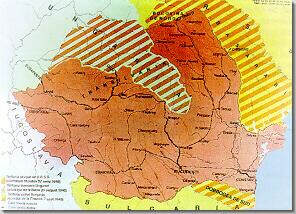
Romania's map with the
territorial losses of the '40s
|
The serious crisis in the summer of
1940 led to the abdication of King Carol II in favour of his son
Michael I (September 6, 1940); equally, it led to General Ion Antonescus
take-over of the government (he became a Marshal in October 1941).
In an effort to win support from Germany and Italy, Ion Antonescu
joined forces in government with the Iron Guard Movement. The Movement
attempted by way of the rebellion of January 21-23, 1941 to take
over the entire government and, as a result, it was eliminated from
politics.
|
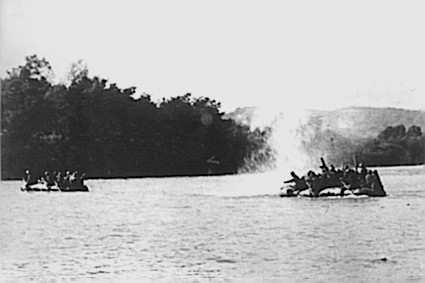
June 22, 1941: the Romanian
army crosses the river Prut
to liberate Bessarabia occupied by the Soviets
|
Wishing to get back the territories
lost in 1940, Ion Antonescu participated, side by side with
Germany, in the war against the Soviet Union (1941-1944).
|
The defeats suffered by the Axis powers
led after 1942 to enhanced attempts made by Antonescus regime,
as well as by the democratic opposition (Iuliu Maniu, C.I.C.
Bratianu) to take Romania out of the alliance with Germany.
On August 23, 1944, Marshal Ion Antonescu was arrested under the
order of King Michael I.
| The new government,
made up of military men and technocrats, declared war on Germany
(August 24, 1944) and so, Romania brought her whole economic
and military potential into the alliance of the United Nations,
until the end of World War II in Europe. |
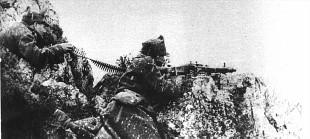
Romanian machine gunners in action
in the mountains of Czechoslovakia
|
|
Despite the human
and economic efforts Romania had made for the cause of the
United Nations for nine months, the Peace Treaty of Paris
(February 10, 1947) denied Romania the co-belligerent status
and forced her to pay huge war reparation. payments; but the
Treaty recognized the come-back of north-eastern Transylvania
to Romania while Bessarabia and Northern Bukovina stayed annexed
to the USSR.
|
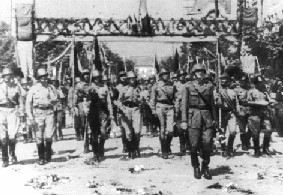
The Romanian army was triumphal received
in all the localities of Transylvania
|
On the territory of Romania Soviet
troops were stationed and the country was abandoned by the Western
powers, so the next stage brought a similar evolution to that of
the other satellites of the Soviet Empire. The whole government
was forcibly taken over by the communists, the political parties
were banned and their members were persecuted and arrested; King
Michael I was forced to abdicate and the same day the peoples republic
was proclaimed (December 30, 1947).
|
The single-party dictatorship
was established, based on an omnipotent and omnipresent surveillance
and repression force.
The industrial enterprises,
the banks and the transportation means were nationalized (1948),
agriculture was forcibly collectivized (1949-1962), the whole
economy was developed according to five-year plans, the main
goal being a Stalinist type industrialization. Romania became
a founding member of COMECON (1949) and of the Warsaw Treaty
(1955).
|
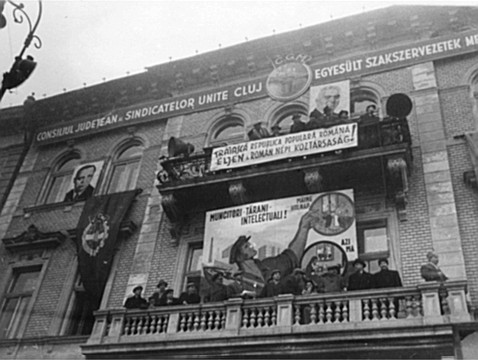
The communists took charge of the state,
guided by their utopian, noxious creed
|
At the death of Gheorghe Gheorghiu-Dej
(1965), the communist leader of the after-war epoch, the party leadership,
which was later identified with that of the state as well, was monopolized
by Nicolae Ceausescu. In a short period of time he managed
to concentrate into his own hands (and those of a clan headed by
his wife, Elena Ceausescu) all the power levers of the communist
party and of the state system. Romania distanced herself from the
USSR (this publicy inaugurated in the "Statement" of April 1964);
the domestic policy was less rigid and there was some opening in
the foreign policy (Romania was the only Warsaw Treaty member-state
that did not intervene in Czechoslovakia in 1968); all this, as
well as the political capital built on such a less Orthodox line
were used to consolidate Ceausescus own position, to take over
the whole power within the party and the state. The dictatorship
of the Ceausescu family, one of the most absurd forms of totalitarian
government in the 20th century Europe, with a personality cult that
actually bordered on mental illness, had as a result, among other
things, distortions in the economy, the degradation of the social
and moral life, the countrys isolation from the international community.
The countrys resources were abusively used to build absurdly giant
projects devised by the dictators megalomania; this also contributed
to a dramatic decline of the populations living standard and the
deepening of the regimes crisis.
|
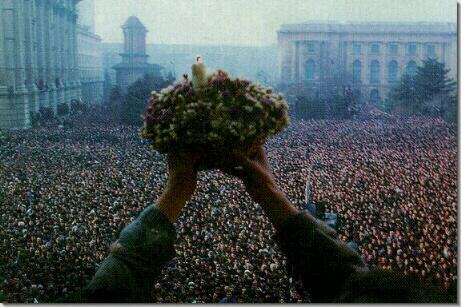
The Romanian Revolution of December 22, 1989
|
Under these circumstances,
the spark of the revolt that was stirred in Timisoara on December
16, 1989 rapidly spread all over the country and in December
22 the dictatorship was overthrown owing to the sacrifice of
over one thousand lives. |
The victory of the revolution opened
the way for a re-establishment of democracy, of the pluralist political
system, for the return to a market economy and the re-integration
of the country in the European economic, political and cultural
space.
|
